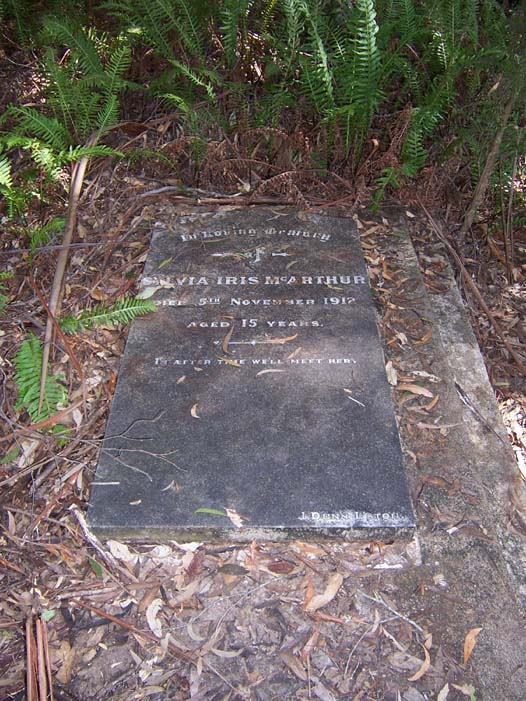
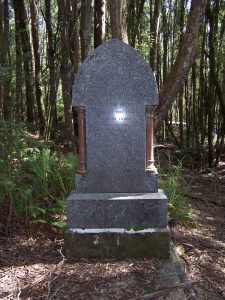
The story of Balfour is told by two graves in a highland cemetery in north-western Tasmania. For more than a century, lying side by side, William Murray and Sylvia McArthur have been fixed silently in their interlocking roles in what historian Geoffrey Blainey called the ‘Indian summer’ of Tasmania’s first mining boom.
There is an interesting dynamic between these two people, who were interred on consecutive days in November 1912. William Murray was a 51-year-old husband and father of two, Sylvia McArthur a 15-year-old schoolgirl. He has Doric columns on his granite headstone, which is reputed to have been sent out from Scotland. She has a slab from J Dunn and Co, Launceston, and, as their graves suggest, they represented different social strata. As one of the owners of the principal mine, the Copper (Murrays’) Reward, William Murray was from the big end of town, living in what was once called ‘the mansion’. Sylvia McArthur was part of the globe-trotting fraternity of mine workers, the community that follows the speculators, grounded in the realities of remote mining towns a century ago, physical and cultural isolation, poor sanitation and health care. Sylvia would have lived in a corrugated iron hut, one of those described as looking like ‘opened out sardine cans’.[1] She is believed to have died of typhoid. William Murray died by putting a gun to his temple, reputedly because of financial and marital collapse stemming from the Copper Reward mine.[2] So, in different ways, they were both casualties of Balfour’s frenzied mining speculation.
Sylvia McArthur’s story begins with the marriage of William McArthur, one of nine children born to Scottish bounty immigrants, to Catherine Dolan, the daughter of Cygnet farmers.[3] They married in Zeehan, where he was a miner and she a housemaid.[4] Two of William’s brothers, Robert and John, likewise followed the mining profession wherever there was work.[5] At Zeehan in 1897 Catherine produced their second daughter, Sylvia Iris McArthur.[6] Emphatic endorsements of the Mount Lyell copper boom were then rising in Queenstown, Strahan and Zeehan. Built on a grand scale in 1898, Zeehan’s Gaiety Theatre and Grand Hotel had a stage larger than that of Hobart’s Theatre Royal and more seating than Hobart’s Town Hall.[7] Zeehan’s silver mines had also peaked, but the field was beset by shallow lodes and problems of ore treatment.
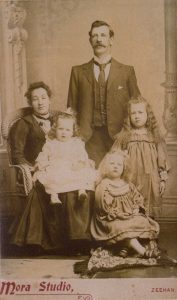
Tragically, in 1904 Catherine McArthur died after a short illness at the age of only 27, moving her husband to verse:
‘Tis hard to break the tender cord,
When love has bound the heart.
Tis hard, so hard, to speak the words:
We for a time must part.
Dearest love, we have laid thee
In the peaceful grave’s embrace,
But they memory will be cherished,
Till we see thy heavenly face’.[8]
By 1908, when William re-married, and with 20-year-old Marion May Delaney started adding boys to his four girls, Zeehan was in decline.[9]
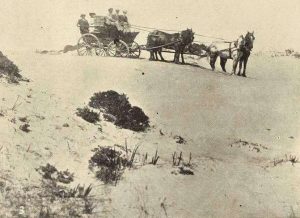
The new boom town was Balfour. It was remote even by mining field standards, a shanty town lodged somewhere between Circular Head and the ‘true’ west coast. No road, railway or deep-water port served it. The Balfour coach could be bogged in beach sand or swamped by the Southern Ocean. Yet by the spring of 1909, investors were agog at the 1100 tons of ore, averaging about 30% copper, which the brothers William and Tom Murray had somehow dispatched to market. In October 1909 a report circulated that the Murrays had sold their Copper Reward mine for £50,000—a claim they denied.[10] The Balfour copper field was soon being hailed as a second Mount Lyell.[11]
By October 1911 William McArthur had secured the position of engine driver at the Copper Reward. It took his family a fortnight’s travel from Zeehan via Burnie and Stanley to join him at Balfour. Rough weather held up their voyage on the ketch HJH, forcing passengers ashore five kilometres from the Woolnorth stock station. Finally, a four-hour ride on the new horse-drawn Temma-Balfour tramway delivered the family to its remote new home.[12]
Balfour had already suffered the obligatory typhoid epidemic of the early life of a mining town by the time fourteen-year-old Sylvia McArthur arrived. The Circular Head Council apparently did not take much notice of this, because it afterwards suggested to the Balfour Advisory Board that it dump the town’s nightsoil in the Frankland River, presumably downstream of the local recreational area and fishing hole.[13] A sanitary inspector despatched to Balfour after the typhoid outbreak found only one unsanitary drain at the Balfour Hotel, plus the suspicion that a pig was being kept on that premises—apparently in anticipation of King George V’s coronation in June 1911, when it was patriotically sacrificed.[14]
William Murray was out of town at that time. Having taken an eighteen-year-old bride, the forty-eight-year-old was honeymooning in England.[15] In August 1911, when Hazel and baby Jean Murray saw Balfour for the first time, they took up residence in what one man called the ‘mansion’, perhaps the only house in town blueprinted by an architect.[16] Perhaps the Murrays also had acetylene lighting, which would have placed them ahead of the underground miners in the candle-lit Copper Reward.
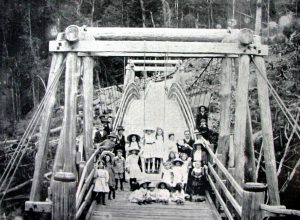
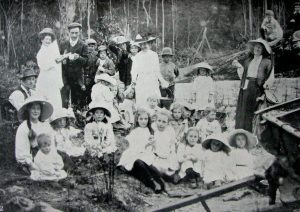
The McArthurs began to live their life in the social pages in January 1912, when Sylvia wrote her first letter to the Weekly Courier newspaper. It is through her words and her father’s photos that we get the story of everyday life in a remote settlement. Sylvia went from a very large school at Zeehan to a one-teacher operation of 23 students at Balfour. She stopped attending because there were no girls of her own age, and she felt as lonely at school as she was at home. Instead, she carried her father’s crib to the mine and looked after her younger siblings.[17] Her sisters became schoolteachers, and Sylvia’s own love of small children is very evident. For amusement she collected postcards and read copiously. The Christmas sports and picnic was the highlight of the social calendar. There was also a dance every few months to the tune of a piano accordion. Sylvia enjoyed the fern gullies and glades of the nearby Frankland River, a favourite picnic spot where walks were taken and the blackfishing was lively.[18]

One day she ventured underground at the Copper Reward. Her permanent interment underground was six months away when she looked to a future beyond the transitory mining town, one she would never know:
‘It was the first time I had been down a mine. I think it is a funny feeling one has whilst going down in a cage … Whilst I was down below a gentleman took a flashlight photograph of us. We all looked like ghosts, for our faces were so white. However, I would not like to leave Balfour without being able to say I was down a mine’.[19]
In her final letter to ‘Dame Durden’ of the Weekly Courier in October 1912, Sylvia described a concert given by the Balfour schoolchildren, illustrated, as usual, by her father’s pictures.[20] Her fatal illness may have been brewing even as the newspaper went to press.
What was William Murray’s condition? It must have been tempting for the Murrays to start living the good life that the speculation promised, and which could easily have landed them in debt. Perhaps the brothers had missed their big chance. It has been claimed that they refused an offer of £30,000 for the mine, a decision they may have come to regret.[21] William Murray shot himself in his home at Donald Street, Balfour, on 4 November 1912, reputedly as part of an unfulfilled double suicide pact with Tom.[22] Sylvia McArthur died in great pain next day ‘from a complication of complaints’ after a three-week illness.[23] She was buried overlooking the Frankland River that she loved. Her heartbroken father described the scene in the Weekly Courier:
‘For she’s sleeping on the hillside,
Where the morning sun will shine,
‘Mid a scene of ferns and dogwood,
Fringed with wild clematis vine,
With its tender fibres clinging,
Drawing close to the boughs above,
As our hearts are drawn to Sylvie,
By the tender cords of love.
And the fiercest storm in winter,
As it rages on the shore,
Will not disturb you, dearest Sylvie,
Where you sleep for evermore’.[24]
Ferns and dogwood still guard William Murray and Sylvia McArthur’s final resting-place. In fact the scrub has grown up so much that the cemetery’s river view has been lost. The ‘lonely spot near Balfour’, as William McArthur described it, is lonelier than ever.
[1] ‘Mount Balfour’, Circular Head Chronicle, 9 February 1910, p.3.
[2] See, for example, Heather Nimmo’s play ‘Murrays’ Reward: a play in two acts’.
[3] Thanks to Edie McArthur for help with McArthur family background. For Catherine Dolan, see birth registration no.1352/1877, Cygnet, to Thomas Dolan and Agnes Dolan, née Harrison.
[4] Marriage registration no.838/1895, Zeehan. Catherine gave her age as 18 but she was only 17; William was 28.
[5] Thanks to Edie McArthur for help with McArthur family background.
[6] She was born 16 October 1897, registration no.3194/1897, Zeehan.
[7] ‘Gaiety Theatre’, Zeehan and Dundas Herald, 1 November 1898, p.4.
[8] Editorial, Zeehan and Dundas Herald, 23 July 1904, p.2; memorial to Catherine McArthur, held by Edie McArthur.
[9] Marriage registration no.1389/1908, Zeehan.
[10] ‘Mining’, Mercury, 26 October, p.3; and 4 November 1911, p.2.
[11] ‘The far north-west’, North Western Advocate and the Emu Bay Times, 7 February 1911, p.2.
[12] Sylvia McArthur; in ‘Dame Durden’, ‘Young folks’, Weekly Courier, 11 January 1912, p.3.
[13] See ‘Balfour’, Circular Head Chronicle, 21 December 1910, p.2; and 18 January 1911, p.3.
[14] For the pig suspicion and the unsanitary drain, see ‘Balfour’, Circular Head Chronicle, 21 December 1910, p.2 and Circular Head Chronicle, 29 March 1911, p.2 respectively. For the pig slaughter, see the exchange of poems by JW Lord (‘Breheny’s pig’, Circular Head Chronicle, 21 June 1911, p.2 and 26 July 1911, p.4) and ‘Daybreak’ (Clement Lewis Gray), ‘RIP’, Circular Head Chronicle, 5 July 1911, p.3.
[15] ‘Social news’, Star (Sydney), 29 January 1910, p.16.
[16] ‘Mount Balfour’, Circular Head Chronicle, 9 February 1910, p.3; TB Moore diaries, 30 April 1912, ZM5641 (Tasmanian Museum and Art Gallery).
[17] Sylvia McArthur; in ‘Dame Durden’, ‘Young folks’, Weekly Courier, 13 June 1912, p.3.
[18] Sylvia McArthur; in ‘Dame Durden’, ‘Young Folks’, Weekly Courier, 1 February 1912, p.3; 13 June 1912, p.3; 18 July 1912 p.3; 3 October 1912, p.3; Mavis McArthur; in ‘Dame Durden’, ‘Young Folks’, Weekly Courier,18 July 1912, p.3.
[19] Sylvia McArthur; in ‘Dame Durden’, ‘Young folks’, Weekly Courier, 13 June 1912, p.3.
[20] Sylvia McArthur; in Dame Durden, ‘Young folks’, Weekly Courier, 3 October 1912, p.3.
[21] E Payne, ‘Balfour mine’, Examiner, 19 March 1951, p.2.
[22] The Circular Head Chronicle (‘Deaths at Balfour’, 6 November 1912, p.2) reported merely that Murray had ‘died suddenly’. The coroner found that Murray died of a self-inflicted ‘gunshot wound to the head … while of unsound mind’ (see SC195-1-82-13112, [TAHO]).
[23] She died 5 November 1912, registration no.652/1912, Montagu. See also ‘Deaths at Balfour’, Circular Head Chronicle, 6 November 1912, p.2. The official record places her death 10 days later. No inquest was conducted.
[24] Poem by William McArthur published in Dame Durden, ‘Young folks’, Weekly Courier, 21 November 1912, p.3.
Really enjoyed that Nic, Thanks. What a sadly life for such a young girl ;(
Thanks Val, it’s terribly sad. Even sadder to think that the family was forced to move on, to the north-east, making it virtually impossible for them to visit Sylvia’s grave. I have to thank Edie McArthur for photos and information.
Sylvia babysat for the Murrays, along with her sisters before they left Balfour to become teachers. She had two older sisters Gladys May and Florence and one younger Laurel Mavis. All three siblings were teachers and I have no doubt Sylvia would have been a teacher too had she lived beyond her teens. Her step mother was a contralto and was well known in both Balfour and Zeehan before and Later Launceston. She entertained by singing and playing the piano at dances. William McArthur played a part, they were very social people and highly respected in both districts. As Nic has said the second family consisted of two sons Bill and Alan and a daughter Gwen who also sang and played piano as does her daughter Kay, sing and plays instruments.
I met Mary as a eighty plus year old along with her nephew Miles Ford. She was visiting Tasmania and we had corresponded prior. I was told she was alive at that time and when I wrote to her, she told me of the photos she had of the mine and needed to have them identified. As it was there were several with our family in them
It is a pity the Cemetary has not been maintained, but then it is very remote.
Thanks for the story Nic. How do I get a copy of the original Magazine where this story is to be found please.
Edie, good to hear from you, it would have been hard to write this story without your input. I had heard that Sylvia babysat for William and Hazel Murray, but had no proof of it, and when I read that William and Hazel arrived in Balfour as a married couple with not only their first child but a maid, I thought there was too much doubt about the babysitting to justify mentioning it. This story has not appeared in a magazine. However, the stories of the Murray brothers and Sylvia McArthur will be in my next book.
I guess the maid would do the cleaning and would have some time off. The girls were not full time babysitters, just like anyone would do for pocket money today I guess, when needed. They were very close to the Murray family.
I knew William McArthurs second wife. Marion may McArthur nee Delaney. Also two of Sylvia’s surviving sisters Gladys May and Laurel Mavis. All three children from the second marriage were present and alive in 1966. All three were at our wedding. Florence had died in the 1950’s.
I look forward to your next book Nic.
Thanks again, Edie, for that information. How lucky you were to meet them. I take your point about the maid and the babysitting. I think there is a photo of Sylvia with a baby which was supposed to be the Murrays’.
The baby was Mary. Williams daughter she gave it to me. I think it is Florence and not Sylvia in the photo, but Mary said it was Sylvia. I thought it may have been her older sister, but you would think she would know if it was, wouldnt you?
I have to correct myself here as the baby I met as a 80 plus year old was Jean Mears nee Murray, Mary was the younger sister born just before Bill Murray returned to Balfour ahead of his family. I still have her letter she wrote to me, before we met.
OK, Edie, thanks for that. I did wonder if it was Sylvia or not. I noticed yesterday in going through the Weekly Courier that in 1913, when the McArthurs were in the north-east, William McArthur submitted some photos of Zeehan to that newspaper. They must have been old photos from when the family lived there. One photo, a view of Zeehan from Manganese Hill, had his family in the foreground, including a girl with plaited hair, the way Sylvia’s hair is done in one of the Balfour photos.
Nic,
By chance while on a quick return visit to Tasmania I stumbled on the recently published book, “The Balfour Correspondent” – James Dryburgh, stirring many memories.
My immediate family lived in Smithton for 17 years, and had the opportunity to visit Balfour quite a few times.
Our special interest was as my husband is a direct descendant of Kate Valencia Murray and William Wilbraham Ford, we were familiar with the story of William Wallace Fullarton Murrary (Kate’s brother). We refer to William as Bill and his brother as Tom.
Kate’s children, twins Wallace & Allan Ford and daughter Connie (McDonald) kept life-long contact with their cousins Jean and Mary, (the daughters of Hazel and Bill.)
Jean always told us that her father sent the young family away from Balfour, before he committed suicide.
My husband and I had the pleasure of taking Jean and Mary back to Balfour in their latter years, to visit their father’s grave for the first time, in that peaceful place. Mary by that time was too frail to take the final walk to the graves, but Jean reached her goal. It really was a special day.
Jean, a dynamic lady was always a sharp thinker, and clearly remembered Sylvia as her babysitter, and so seeing Sylvia’s grave was another moment. As we drove her around Balfour I remember her naming the streets and recalling various houses, even the pet dogs!
In latter years Jean recalled her Uncle Tom, arriving in Sydney unannounced for a visit. As a young girl she was embarrassed as he arrived carrying a “bluey”. With the hindsight of old age she was ashamed of herself for her reaction.
Jean did marry and her husband Frank Mears died tragically in an accident in 1946. Jean passed away in 2009.
We have a small collection of Balfour photos which Jean gave us to copy. It includes one of Sylvia, Jean and two other young girls; the Murray’s on their front verandah and various miners and scenes.
A favourite memory of Balfour remains with it bursting with the vibrant colour of foxgloves, contrasted to the quiet peace of what remains of the cemetery.
Thanks for writing, Jane, I’m delighted to hear from you, and have replied from my personal email.
Hi Jane, just letting you know that I am having trouble emailing you, not sure if the problem is my email server or yours. I will keep trying.
Nic, thank you for your in depth research. I have a postcard of the picnic at the Frankland River and the image in the Weekly Courier is cropped a little. I had not been able to identify the photographer, which you have done and his daughter in the bottom left of the photograph. Thank you again.Cannot get the Weekly Courier on Trove.
I have done my own research and can identify a few more. The picnic was given by Mrs Leonore (Lorrie) Wilkinson Gaffney (wife of Frank and sister of Jim Wilkinson), who is in the center with a “billy”. She labels herself the “mayoress” in the message on the postcard and the billy possibly has oranges in it which Frank brought in especially for the picnic.
The gentleman in the top left is Mr. A.O. McCall who opened the Balfour State School in November 1911. Miss Effie Campbell on the left of Mr McCall is pouring him a cup of tea.The lady on the far right in a dark cardigan and large floppy white hat is Mrs Sarah Ann Matthews, wife of the Balfour baker William James Matthews.
Frank and Leonores’ children, Francis and Margaret (Greta) are in the photograph. Margaret is dead centre on the bottom and is the girl on the left of centre holding an orange with her friend. Francis is on the top right sitting on the log. He is the one in light coloured clothes directly above Mrs Matthews.
The postcard was sent under cover so I do not know the recipient but the writer is “LVG” and Mrs Gaffney has identified a couple of the characters and the others I have sourced myself.
Each has an interesting history of where they came from and where they went post Balfour. Nic if you want a copy of the postcard and the message on the reverse let me know and I will leave it with Mike Gray at Cracked and Spineless along with my research data. He speaks volumes on your work. Kind regards John.
Hi John, that’s fascinating! Thanks for your research. I am so glad you were able to identify people in that photo, especially the Gaffneys. The Gaffneys and the Murrays, of course, were so important in the history of Balfour. Quite appropriate that Leonore Gaffney should call herself the mayoress. John, I’d love to see a copy of the postcard and the message on the reverse, but don’t go to any trouble. Mike is very kind!
Nic I have copied my work on the picnic postcard and as I am going to town for lunch on 17th I will leave it with Mike Gray. I am on the TPS committee with him so I doubt he will mind. I will now rewrite my Balfour philatelic history to include the McArturs and Murrays.
We all know it is a small world but the message left by Jane Ford prior to mine rang a bell as I knew her husbands second name was Wilbraham. My wife was Janes bridesmaid. (This is Tasmania). I have been in contact with Jane so I reckon my next article in the Courier will have to be a Balfour tale. So great when all the pieces start to come together.
I will rewrite my postcard description to encompass new details provided by you.
Thank you and kind regards John C
Hi John,
Are you able to identify the lady on the left of that same photo of the picnic who is pouring some wine or some other fluid into the gentlemans cup. I have that some lady in one of the Balfour mine photos, inside a mine cage with William McArthur and his wife Marion (May) McArthur. On page 51 of the Balfour Correspondent. I have no idea who she is.
Sorry John, I see you already have identified the lady pouring Mar A O McCall is a Miss Effie Campbell.